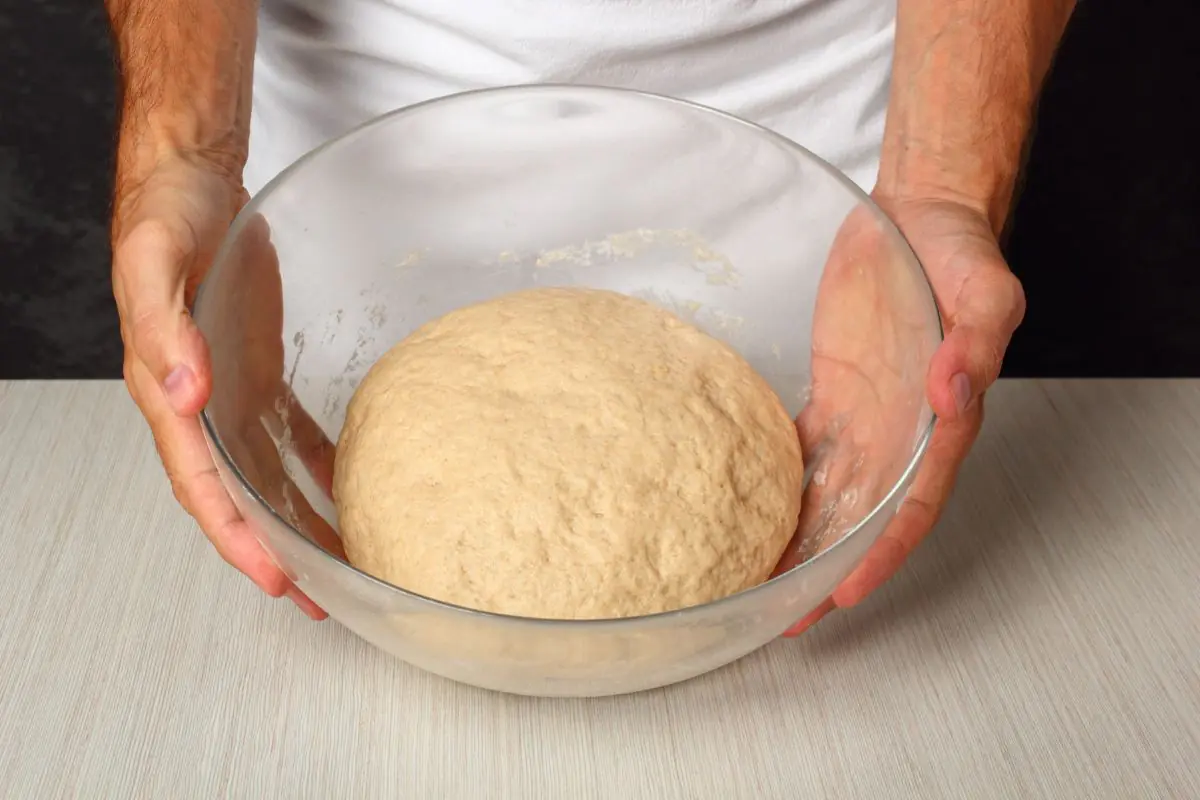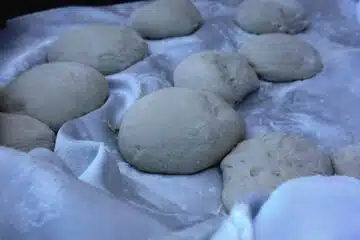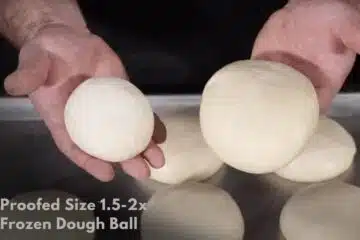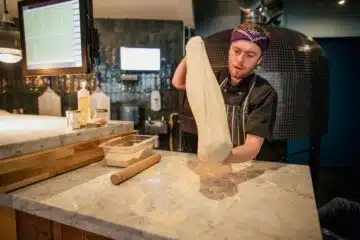If your pizza dough doesn’t rise, check the yeast’s expiration date and ensure the dough is in a warm, draft-free area. Adjust liquid temperatures or try adding fresh yeast to the mixture.
Understanding the pivotal role of yeast in the rising process of pizza dough is key to troubleshooting and improving your baking skills. Yeast, a living organism, is the primary catalyst for dough expansion. It thrives in an optimal environment, and any deviation from this can hinder its activation, resulting in flat, dense dough.
Factors like expired yeast, incorrect measurements, or an unsuitable rising environment can also contribute to this issue. But fear not, as you have the power to troubleshoot these common issues with your pizza dough. By finding a perfect balance of warmth and time and using quality, active ingredients, you can create the ideal conditions for yeast to thrive. This ensures your dough will rise and result in a delicious, fluffy pizza crust. Remember, you’re not just fixing baking mishaps; you’re mastering the art of culinary growth.

Credit: papasprimopizza.com
Rising Issues With Pizza Dough
Creating the perfect pizza dough feels like an art and a science combined. But sometimes, no matter how careful you are, your dough will stay the same. This can be frustrating, but remember, you’re not alone in this. Many baking enthusiasts face similar challenges. Understanding the reasons and knowing how to fix it is essential. Your pizza dreams are not over; let’s troubleshoot together!
Troubleshooting Dough That Won’t Rise
- Check Your Yeast: Old or inactive yeast often leads to flat dough.
- Temperature Trouble: The dough needs a warm spot to rise properly.
- Time Troubles: Rushing can prevent dough from rising.
Did your dough get enough time to ferment? If not, give it more time. Pizza dough needs patience. It could just need a few more hours to puff up with pride.
Common Causes For Lackluster Dough
| Cause | Effect | Solution |
| Expired Yeast | No rise | Use fresh yeast |
| Incorrect Water Temperature | Yeast dies or fails to activate | Use lukewarm water |
| Improper Kneading | Lacks structure | Knead dough for 8-10 minutes |
| Too Much/Too Little Flour | Too heavy or too sticky | Measure ingredients precisely |
Each case has a simple solution. Fresh yeast, proper water temperature, adequate kneading, and correct measurements will set your dough on the right path. And here’s the best part: the dough is forgiving. Just a few tweaks can breathe life back into it, giving you the confidence to experiment and learn from your baking journey!
The Importance Of Yeast
Have you ever been in a situation where your pizza dough remained flat? Yeast is often the key player behind the rise of your dough. This essential ingredient kick-starts fermentation, the magical process that makes dough expand and soften. Skipping on yeast or using it incorrectly can lead to a dense and unrisen pizza crust, turning your culinary masterpiece into a kitchen disaster. Understanding how yeast works helps prevent such mishaps and ensures a perfectly risen dough every time you bake.
Yeast Viability And Dough Rising
Yeast needs to be alive and active to do its job. Dead or old yeast won’t cause dough to rise. To check if yeast is still viable, one can perform a simple test:
- Dissolve a teaspoon of sugar in half a cup of warm water.
- Add 2 1/4 teaspoons of yeast (one packet).
- Wait for 10 minutes.
- Look for bubbles – they mean the yeast is good to go!
If there are no bubbles, the yeast is dead—it’s time to grab a new packet.
Temperature’s Role In Yeast Activation
Temperature control is a critical factor in yeast activation. Yeast becomes dormant below 105°F and dies above 115°F. The sweet spot for yeast activity is between 105°F and 115°F. Maintaining this temperature range is crucial for successful dough rising. A kitchen thermometer is a handy tool to ensure the perfect water temperature for yeast activation.
| Temperature Range | Yeast Activity |
| Below 105°F | Dormant |
| 105°F – 115°F | Active |
| Above 115°F | Dead |
If the room is cool, place the dough in a warm spot. An oven with a light on or a bowl of warm water can provide warmth. Find a cozy corner and give the yeast the best chance to make your dough rise.
Kitchen Warmth Tricks
Let’s talk about Kitchen Warmth Tricks. Sometimes, pizza dough won’t rise. This can happen for many reasons. But don’t worry. The kitchen is full of warmth and gadget tricks. These tricks can wake up your dough. They make it rise well. We will look at easy ways to use warmth. This helps when the dough is stubborn.
Utilizing A Warm Oven
Turn your oven into a warm spot for your dough. First, turn on your oven to its lowest setting. Then, wait just a few minutes. Now, please turn it off. Place your dough inside. Leave the oven door slightly open. Your dough gets a cozy place to rise. It is like a little oven nap that helps it grow.
Trapping Heat With A Bowl Of Water
Another trick is to use a bowl of hot water. Boil water in a kettle. Pour this into a bowl. Now, place this bowl in your oven. Next, put your dough in the oven, too. The water makes the air warm and moist. This is like a spa for the dough. It will rise better because it loves this warmth.
Note: Be careful with these tricks. Check your dough so it does not over-rise. A little patience and these kitchen warmth tricks will save your pizza night!
Kneading: A Necessary Step
Have you ever faced the disappointment of flat, unhappy pizza dough? The secret to a perfect rise lies in kneading. This step is much like giving your dough a good workout. It strengthens the gluten, which provides the dough with structure and elasticity. Without it, your pizza dough might sit there, sulking in the bowl. To rescue a dough that won’t rise, revisit the kneading process with these insights and techniques.
Techniques For Proper Kneading
- Press and Fold: Use the heel of your hand to push the dough away from you, then fold it over toward you.
- Quarter Turns: Rotate the dough 90 degrees after each kneading to ensure even gluten formation.
- Timed Kneading: Aim for 8-10 minutes of consistent kneading to give the gluten a full workout.
How Kneading Affects Dough Rise
The act of kneading does more than mix ingredients. It activates yeast and traps air. These tiny air pockets expand in the warmth of your kitchen. Think of kneading as prepping your dough to become light and airy. Skip this, and you might end up with a dense, chewy crust. So, to get a rise out of your dough, remember: kneading is non-negotiable!
Flour Power In Dough Rising
The rise of your pizza dough can be quite a mystery. Flour plays a pivotal role in this culinary quest. Not all flours are created equal, and the right pick could mean the difference between a deliciously fluffy crust and a flat, tough disappointment.
Impact Of Flour Type
The type of flour you use affects the dough’s ability to rise. High-protein flours, like bread flour, have more gluten. Gluten gives dough elasticity and strength. A stretchier dough traps more gas during fermentation, leading to a better rise.
- All-Purpose Flour: Versatile but lower in protein. Less rise.
- Bread flour is high in protein and yields more rise.
- Whole Wheat Flour: Nutritious but heavy. Rises less than white flour.
Adjusting Flour Measurements
Sometimes, your measurements may be off. Changing your flour-to-water ratio can save the dough.
| Dough Type | Flour to Water Ratio | Action |
| Dense | Too much flour | Add water to the tablespoon |
| Wet | Too much water | Add flour to the tablespoon |
Keep in mind to add small amounts at a time. Check the dough’s texture after each addition.
Remember the Flour Power: Choosing the right type and measuring carefully makes a big difference in the dough’s rise. Now, armed with flour knowledge, you’re ready to create the perfect pizza crust!
Salvaging The Unrisen Dough
Salvaging the Unrisen Dough can feel like a kitchen defeat, but it’s actually an opportunity for culinary creativity. When your pizza dough refuses to puff up, don’t toss it just yet. There are several ways to give unrisen dough a new purpose, ensuring your efforts and ingredients are well-spent.
Adding More Yeast
Did the yeast fail to activate? It’s possible to give the dough a second chance. First, check the expiration date on your yeast. If it’s still good, try the following steps:
- Measure a small amount of warm water (about 1/4 cup).
- Mix in a teaspoon of sugar and dissolve it fully.
- Sprinkle half a teaspoon of active dry yeast into the water.
- Wait for 10 minutes for the yeast to activate. It should bubble and expand.
- Mix the active yeast mixture into your dough.
- Knead well and give it a second rise, keeping it in a warm, draft-free area.
Repurposing The Dough
Transform your pizza dough into something new with these ideas:
- Flatbreads: Roll out thin and cook in a hot skillet for a quick snack.
- Focaccia: Add olive oil, herbs, and sea salt, and bake it as is.
- Breadsticks: Twist the dough, add garlic butter or cheese, and bake.
- Cookies: Yes, with added sugar, eggs, and butter, dough can become dessert.
Each repurpose option offers a unique way to enjoy your creation despite the initial hiccup. No rise, no problem!
Preventive Measures For Next Time
Didn’t you get the rise you were hoping for in your pizza dough? This is a common baking mishap, but let’s ensure it doesn’t repeat.
Here are some preventive steps to take for better results in your next pizza-making adventure.
Proofing The Yeast
- Check the expiration date on your yeast package before using it.
- Use lukewarm water (about 110°F) to activate the yeast.
- Adding a pinch of sugar to the water can help the yeast feed and bloom.
- Give it time—if the yeast doesn’t foam within 10 minutes, start over with new yeast.
Choosing The Right Ingredients
| Ingredient | Tip |
| Flour | Use ’00’ flour or high-protein bread flour for best results. |
| Water | The temperature should be warm to touch, not hot. |
| Salt | Don’t add directly to yeast; it can kill the rise. |
By taking these measures, your dough will have the best chance to rise perfectly for that delicious, homemade pizza experience.

Creative Uses For Flat Dough
Have you ever experienced the disappointment of pizza dough that won’t rise? Fear not! There are still plenty of delicious ways to use this flat dough. Embark on a culinary adventure with creative twists and mouthwatering flavors.
Flatbreads And Other Ideas
Flat dough might not make for the fluffiest pizzas, but it’s perfect for crafting a variety of flatbreads. Transform the dough into a crispy base for toppings or a delicious side to dip into soups and sauces.
- Pita Pockets: Make pockets for falafel or gyros.
- Crackers: Cut into shapes, season, and bake for snacking.
- Naan Bread: Add garlic and herbs and serve with curry.
Roll it out thinner for crispiness. Add seeds or nuts for texture. Get creative with shapes and sizes to delight your taste buds!
Enhancing Flavor Despite The Flatness
While the dough may not have risen, you can still bring it to life with vibrant toppings and fillings. Introduce bold flavors that stand out, creating a blend of taste and texture that’s unforgettable.
- Herbs & Spices: Boost the dough with rosemary, thyme, or za’atar.
- Cheese & Garlic: Combine for a savory twist.
- Sweet Treats: Sprinkle with cinnamon and sugar, bake, and indulge.
Remember to oil your dough well before seasoning. This helps the flavors stick and penetrate, allowing for maximum impact. The flatness can also lead to extra crunch, giving your taste buds a delightful texture to enjoy.
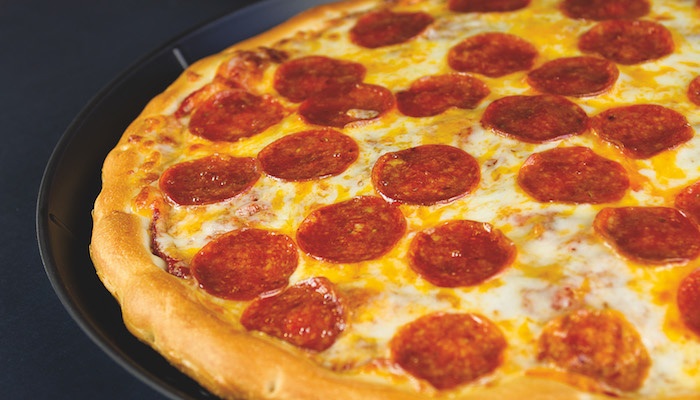
Credit: www.akcrust.com
Frequently Asked Questions
Can You Still Use Pizza Dough If It Didn’t Rise?
Yes, you can use pizza dough even if it doesn’t rise, although the crust will be denser and less fluffy. For best results, consider making a thin-crust pizza with it.
How Do You Fix Dough That Didn’t Rise?
Check the dough’s temperature; it should be warm enough for yeast activation. To encourage fermentation, try adding a teaspoon of sugar or honey. Place the dough in a warmer environment and ensure it’s not overly floured. If time allows, extend the rise period.
Otherwise, prepare a fresh batch with active yeast.
What To Do If My Pizza Dough Hasn’t Risen?
Check the expiration date on your yeast. Ensure your dough is in a warm, draft-free environment for rising. Give it more time, as some doughs rise slower. If no rise occurs, you may need to start over with new yeast.
How Do You Force Pizza Dough To Rise?
To make pizza dough rise faster, use warm water for the dough mix and keep it in a warm place. Cover the dough with a damp cloth to retain moisture. Adding a small amount of extra yeast can also accelerate the rising process.
Conclusion
Encountering uncooperative pizza dough can be disheartening. Don’t let it dampen your cooking spirit. Embrace the tips shared to troubleshoot and salvage the dough—or start afresh if needed. Remember, perfecting your pizza dough is a journey. With each attempt, you’re one step closer to achieving that ideal rise.
Keep experimenting, and happy baking!

As the author of the “Ultimate Pizza Guide: Recipes, Tips & Secrets Revealed,” I’m dedicated to sharing my love for pizza and empowering others to create delicious homemade pizzas with ease. Join me on a journey to uncover the secrets to perfecting your pizza game!
